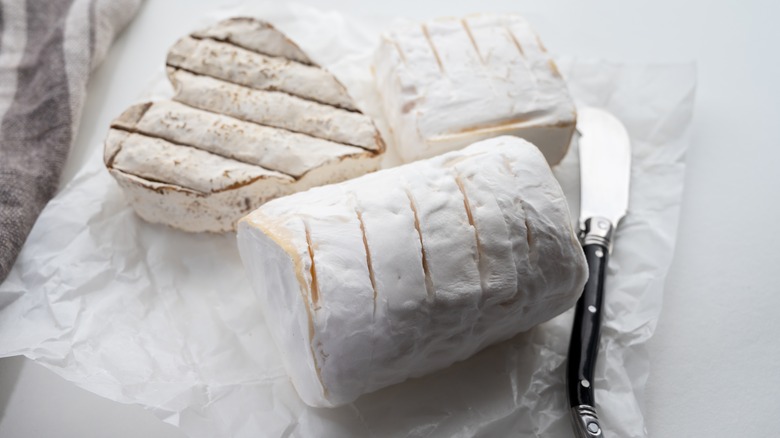The Difference Between Neufchâtel And Cream Cheese
Whether slathered on a toasted bagel or incorporated into a Creamy Buffalo Chicken Dip, cream cheese (and the similar Neufchâtel) makes almost anything taste better with its creamy, light flavor. It also enhances the scrumptiousness of a slice of chocolate chip banana bread or an English muffin on which it has been spread.
While the original, plain cream cheese is used in baking items like cheesecake, cream cheese is available in a wide variety of flavors from strawberry to vegetable, as well as different textures, such as whipped. Often kept next to cream cheese at the grocery store, the American version of Neufchâtel has evolved to more closely taste and resemble cream cheese, per Tastessence. Although where they were first created differs (Neufchâtel in Europe and cream cheese in the United States), their versatility and deliciousness, especially for the latter, have resulted in them being consumed around the world. Bon Appétit notes that cream cheese is used in Japan to make the country's popular soufflé cheesecake.
While many Americans may think of Neufchâtel as cream cheese's lower fat cousin, if comparing the traditional French cheese to the American spreadable cheese, there are significant differences.
One of France's oldest cheeses
Different than cream cheese, both in origin and in the way it is made, Neufchâtel originated in France around 1035, making it one of the country's oldest cheeses, according to Cheese.com.
Unlike cream cheese, Neufchâtel is aged before being eaten, generally for about six to 10 weeks, according to Illinois Extension. To make Neufchâtel, only cow's milk is used to make a spreadable cheese that ultimately must have about 23% milk fat and more than 55% moisture content. Comparatively, cream cheese is created with a combination of unskimmed milk and cream (via Cheese.com). The texture of a traditional French Neufchâtel is different from the American version with its more grainy and crumbly consistency, similar to a Camembert. The French variety also has a rind, and its flavor is described by Cheese.com as being nutty and tasting a bit like a mushroom.
While light cream cheese is often referred to as Neufchâtel, CheeseForum.org cautions that is not accurate because of the different ingredients and processes of being made of the two creamy spreads. However, the American version of Neufchâtel is very similar to cream cheese in both texture and taste, says Illinois Extension, thus resulting in them often being used interchangeably.
Cream cheese: a blend of milk and cream
When Americans set about making Neufchâtel cheese in the 18th century, a combination of milk and cream was used and continues to this day to comprise the dairy product, which by law, needs to be at least 33% milk fat, but not contain more than 55% moisture, per Illinois Extension. It also is not aged and remains a fresh cheese.
How and when cream cheese was first made is debated among food historians, but what is agreed upon is that William Lawrence first made and successfully sold cream cheese in the latter half of the 1800s with the name of Philadelphia, chronicles Bon Appétit. However, while some say that Lawrence accidentally invented the spreadable cheese, Jeffrey Marx wrote to Forward that the earliest known published recipe for cream cheese was in a 1769 newspaper. Castello adds to the debate, contending that cream cheese originated in England and was then reproduced in America.
No matter who can properly lay claim to first creating cream cheese, one thing is consistent — it's made from cow's milk and cream with starter cultures to make a curd that is eventually pressed and filtered to become smooth and creamy, according to Castello. The finished product is often sold in square blocks or tubs for easy spreading.
How to swap Neufchâtel and cream cheese
Knowing the differences between French Neufchâtel and the American version is key when determining how to eat it and use it in recipes, as well as how to swap it with cream cheese. Substituting the American version of Neufchâtel for cream cheese is fairly straightforward considering both are similar in taste and texture. Taste of Home says subbing out Neufchâtel for cream cheese and vice-versa in dips and spreads works well, but may result in a textural change in a cooked dish.
If using Neufchâtel, the recipe will not be as creamy thanks to its lower fat content than cream cheese, says Southern Living. But go ahead and incorporate Neufchâtel in your next cheesecake, frosting, or sauce, encourages Healthline. When it comes to the traditional French Neufchâtel, MasterClass says it will a little tang to any recipe compared to cream cheese, and despite its small differences in texture and taste, can work in place of cream cheese for bagel spreads and frostings. It also should be noted that cream cheese, which doesn't contain rennet, is a vegetarian product, while Neufchâtel is not. Rennet, which helps to create a solid mass from milk, is derived from rennin, which is found in the stomach lining of young goats and calves, (via The Spruce Eats).
While Neufchâtel and cream cheese have their differences, enjoy them in much the same way and appreciate those slight variations.



